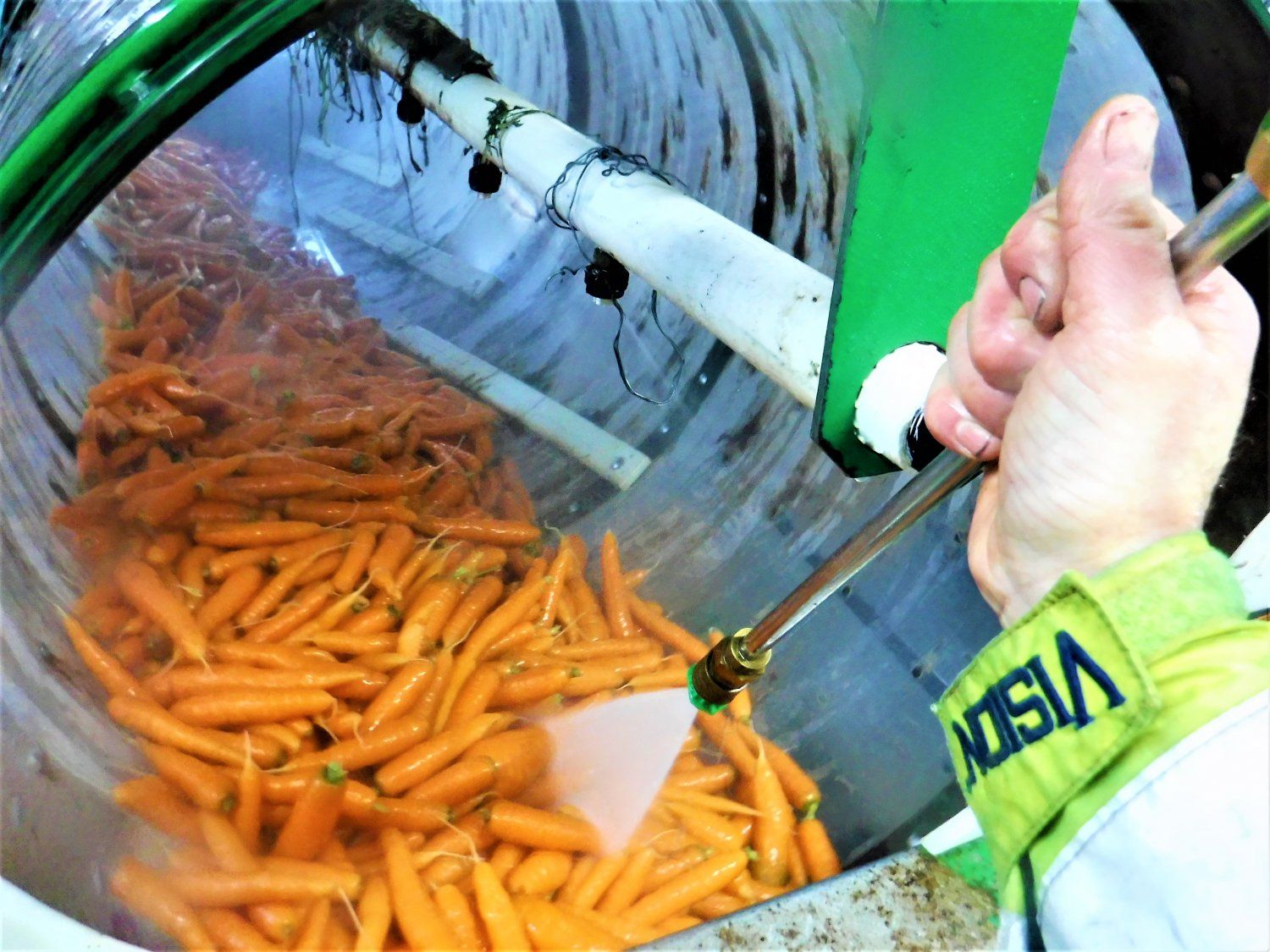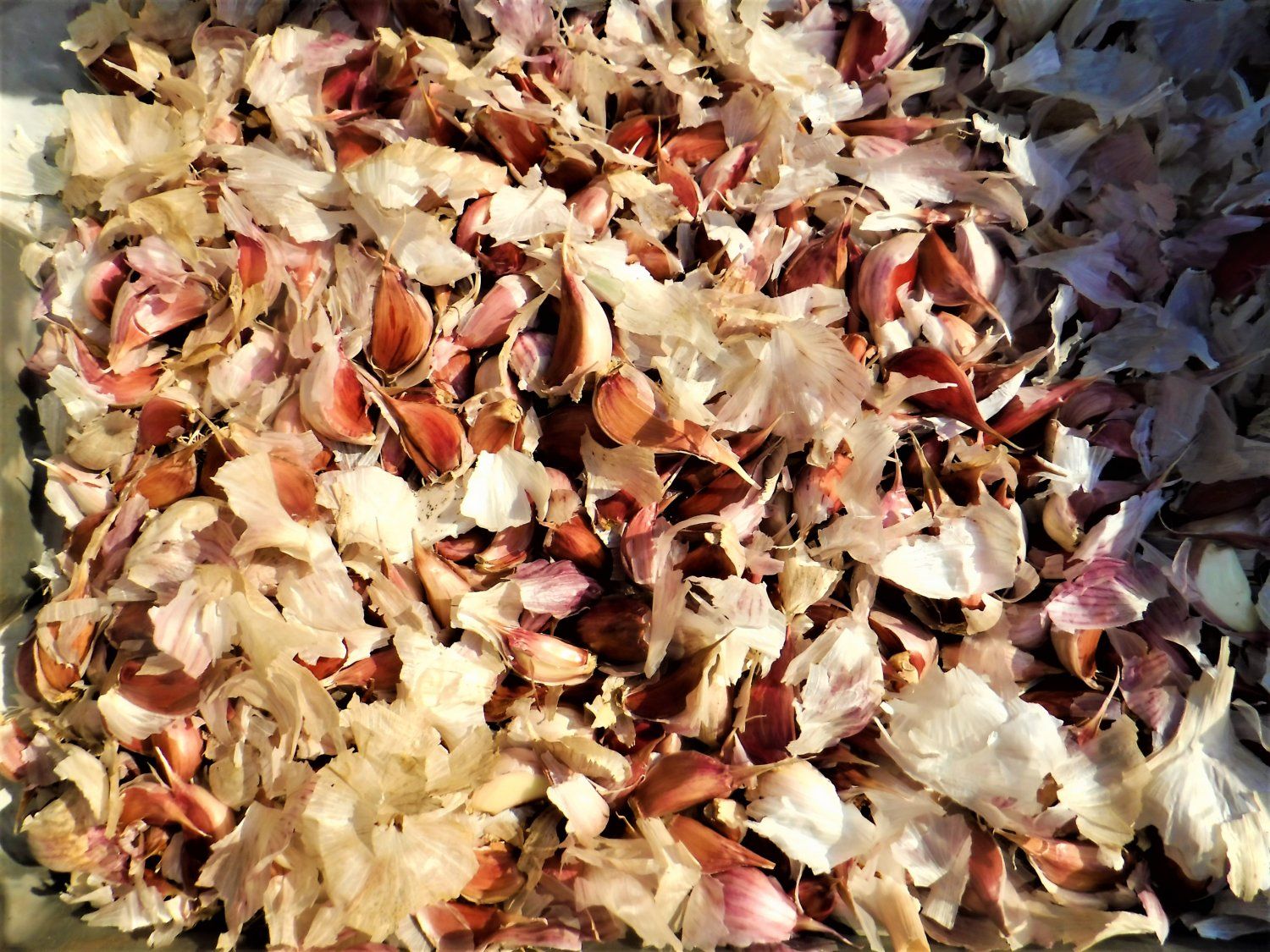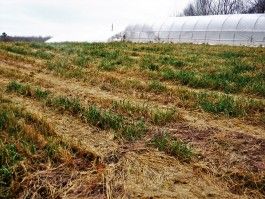We're on the home stretch of finishing the hoophouse prep work for our FINAL planting of the season - garlic!
Most folks plant garlic outside, and it generally does well in our cold climate. We have been planting our garlic in hoophouses in the fall for the last few years for a few reasons. First of all, it provides a different crop to help our veggie family rotations in the hoophouse beds and break up the disease cycle. Secondly, we are able to harvest it a week or two earlier than field planted garlic, and we can plant it a few weeks later than field-planted garlic. Since the soil in the hoops is protected, it's not frozen yet even though the ground outside is getting solid in places now.
We've also got an incredible workload in the fall with all the field crop harvesting, so finding time to prep outside beds and plant garlic hasn't been in the cards. Having the ability to plant it in our hoophouses later, after our last carrots have been harvested, washed, and put away for winter, is just what we need!
Plus, when planted in the protected hoophouses, the smaller cloves of garlic still manage to size up pretty well, so we don't need to be as picky about planting ONLY the biggest bulbs. Fingers crossed that the harvest is good next July and we can have enough big bulbs (and time in our schedule!) to add an additional outdoor planting for harvest in 2023. Sheesh, always thinking so far ahead!
Growing space is much more limited in the hoophouses, so by moving some outside we'll be able to really increase our production. Our goal is to produce enough so that eventually garlic is available with every CSA veggie box delivery from July through the following March. This fall we are putting in a total of 500' worth of densely planted garlic in the hoophouses. Next fall, if all goes well, we should be able to double that planting size!
The hard part of outdoor garlic production for us certified organic growers is finding certified organic straw to mulch the garlic with. Nearly all non-organic straw in our region is sprayed at least twice with herbicides and other prohibited substances, and as such is not usable on certified organic farms. The spray applications typically happen early in the crop production cycle to control weeds, and again just before harvest to desiccate the crop and make it "die" all at once for easy combine harvest.
Organic straw is tough to come by up here, as there are very few organic grain growers, and the straw when available can have more weed seeds than we want (since it wasn't sprayed with any herbicides while it was growing.) Many organic growers also prefer to leave the straw in the field for nutrient cycling instead of baling it up and then buying expensive organic fertilizer to rebalance/remineralize their soils. So unless we grow our own straw (too much to do already here, so that is a no-go!) we'll have to figure out a straw-less garlic production system.
Obviously we are not the only organic farm who has had to scratch their head about this. Over the last few years, I have watched other organic growers in our region successfully growing garlic outdoors without any straw, so that's what we'll try next fall with our outdoor planting. Our hoophouse garlic is grown without any straw, and that's been working well for us the last few years, so it seems worth trying outdoors as well.
The critical thing for garlic is to prevent the spring frost heaving from pushing the garlic bulbs up out of the ground, exposing their roots, and making them have a tough time growing. That little bit of straw typically applied on the crop helps keep the weeds down and retain moisture, but another big benefit is that it helps insulate the soil so that temperature changes happen more slowly and the bulbs of garlic seed are not heaved up. We'll see how it goes!
Anyway, as of Friday morning, we'll have 2 of the 5 beds of garlic prepped in the hoophouses, and hope to finish up the rest of the bed prep next week. Here's what it looks like while we're forking the beds prior to planting the garlic. Look at that soil with nice texture and full of organic matter (and our earthworm friends everywhere!)
But it takes a lot of work to get those beds looking so good! We've been working to remove the tomato vines and clean out the hoops from summer season crops, which takes a while. You can see from the pics below that those tomatoes make quite a mess in there! These pics are from the same house in the picture above, just earlier in the bed prepping process. And it's all hand work in the hoops - no tractors. Boy, those weeds along the side are not kidding around either, are they? Fertile soil is good for crops, but the weeds sure don't mind either.
With over 1500 tomato plants to remove between our slicer and cherry tomato plantings, if each vine is at least 12' long (many were longer than 12' if you can believe it!) that is 18,000 feet of vine, or almost 3.5 miles worth of tomato vine that we have to remove!
Prepping a bed for the next crop means removing all of those vines, hauling out the tomatoes that fell down, pulling any weeds, then following up with a broadfork to loosen the soil, adding minerals and compost, hoeing the bed to incorporate the fertility and make a loose crumbly texture on the surface, then raking it smooth. Slow goin'!
But once it's cleaned up, it sure looks nice. The beds we are not planting to garlic will not be prepped until next spring. Until then, they'll be covered with thick black tarps to kill the weeds that are growing in there now, as well as to help "flush out" a few rounds of weed seeds later in the spring once the soil starts to warm up.
Those seeds will sprout, but without access to any light will die in a few weeks, and the soil will be much nicer and weed-free when we go to plant our tomatoes and cukes next April.
You can see how well the tarp does at keeping the weeds down in the picture below. I pulled the tarp back to inspect and take the photo in an adjacent hoophouse that we tarped earlier in the fall. And the best part is that we didn't have to hoe it to kill the weeds! Certainly the more stubborn weeds with larger root reserves will be able to sprout up in the spring, but their growing reserves will be highly taxed as they fight to grow without light, so when it does come time to hoe them out, they will be stressed and easy to remove. Working smarter, not harder, to get good organic weed control is key.
Meanwhile our outdoor fields are largely protected with stubble from the oat and pea cover crops planted on them this summer, and mowed down over a month ago. It doesn't look like much to the untrained eye, but looking out across those fields of dying cover crops sure makes us farmers happy! The root systems are helping hold the soil together through the winter to prevent erosion and give all the little soil microbes a place to hide out during the winter, and the mowed residue is acting like a mulch to help prevent the soil from getting "freezer burned" and dry out before it's covered with snow. Thank you, cover crops!
Here's what it looked like there before we mowed it down. Seems like forever ago that things were so green!
We had hoped to have brussels sprouts available this week, but sadly the temps outside look too cold to harvest them. The sprouts can freeze - they are frozen still in the centers today on Friday, and it actually makes them sweeter when they do freeze - but like spinach they need to thaw out before harvesting. Otherwise, if picked while frozen, they will thaw to the same consistency as fresh produce you stuck in the freezer and set out to thaw on your kitchen counter. Mushy is NOT a good way to eat vegetables.
We have probably a hundred pounds of brussels sprouts still out there in the field (and they taste incredible!) so we're going to cross our fingers and see if it warms up again later this winter. We're also doing some experiments right now with picking entire stalks and letting them thaw out in the root cellar. We'll experiment on ourselves (hopefully we don't get a mushy-middled brussels sprout surprise...) IF the sprouts thaw on the stalk and retain normal consistency, we might be able to offer them one more time in your CSA boxes. If not, well, we did our best, and we'll be sure to get them all out of the field sooner next winter.
That's it from us at the farm this week. Stay warm out there, and have a great Thanksgiving week ahead!
In community,
Farmer Chris
Great Oak Farm

.JPG)
.JPG)
.JPG)
.JPG)
.JPG)
.JPG)



